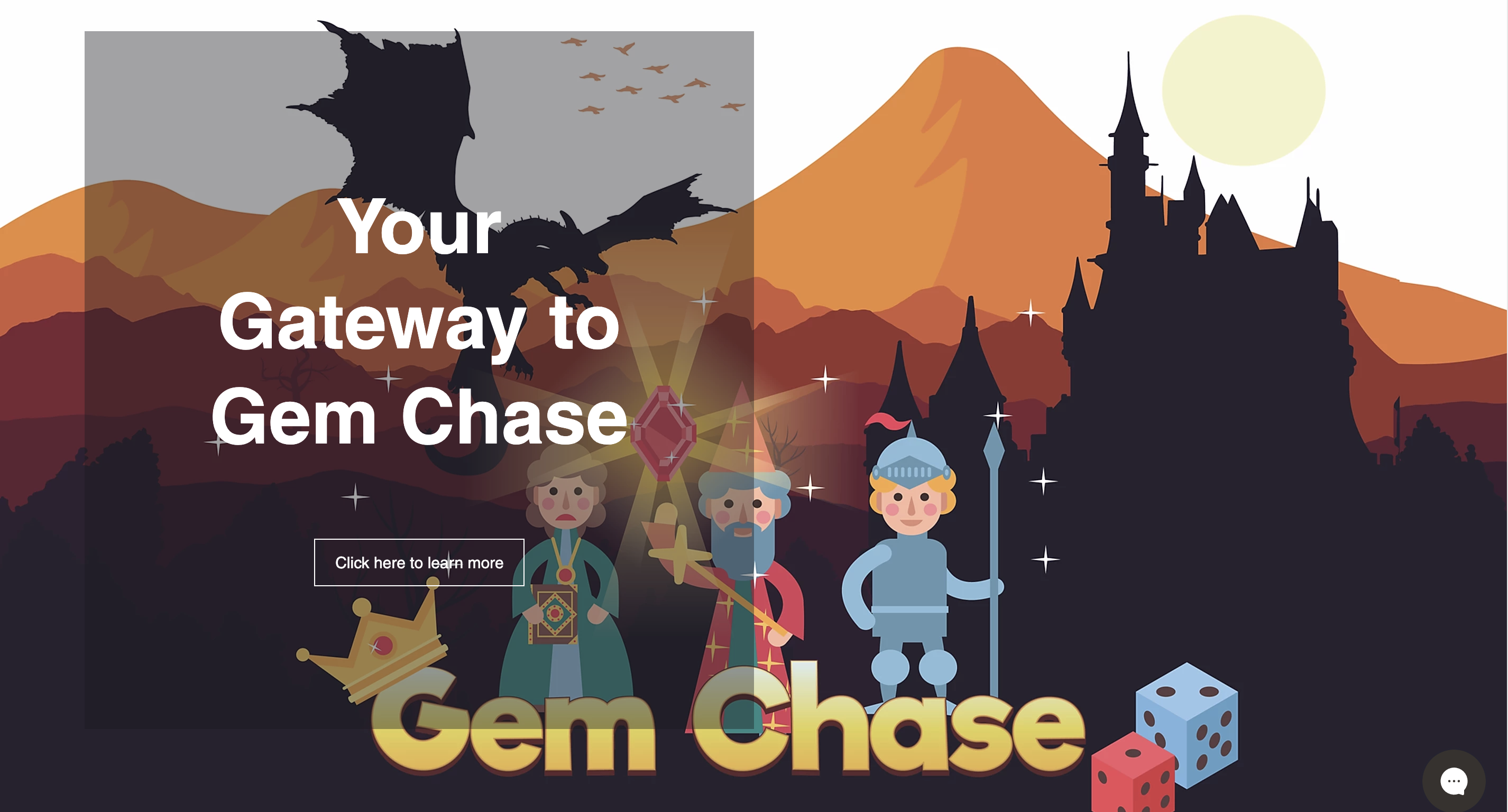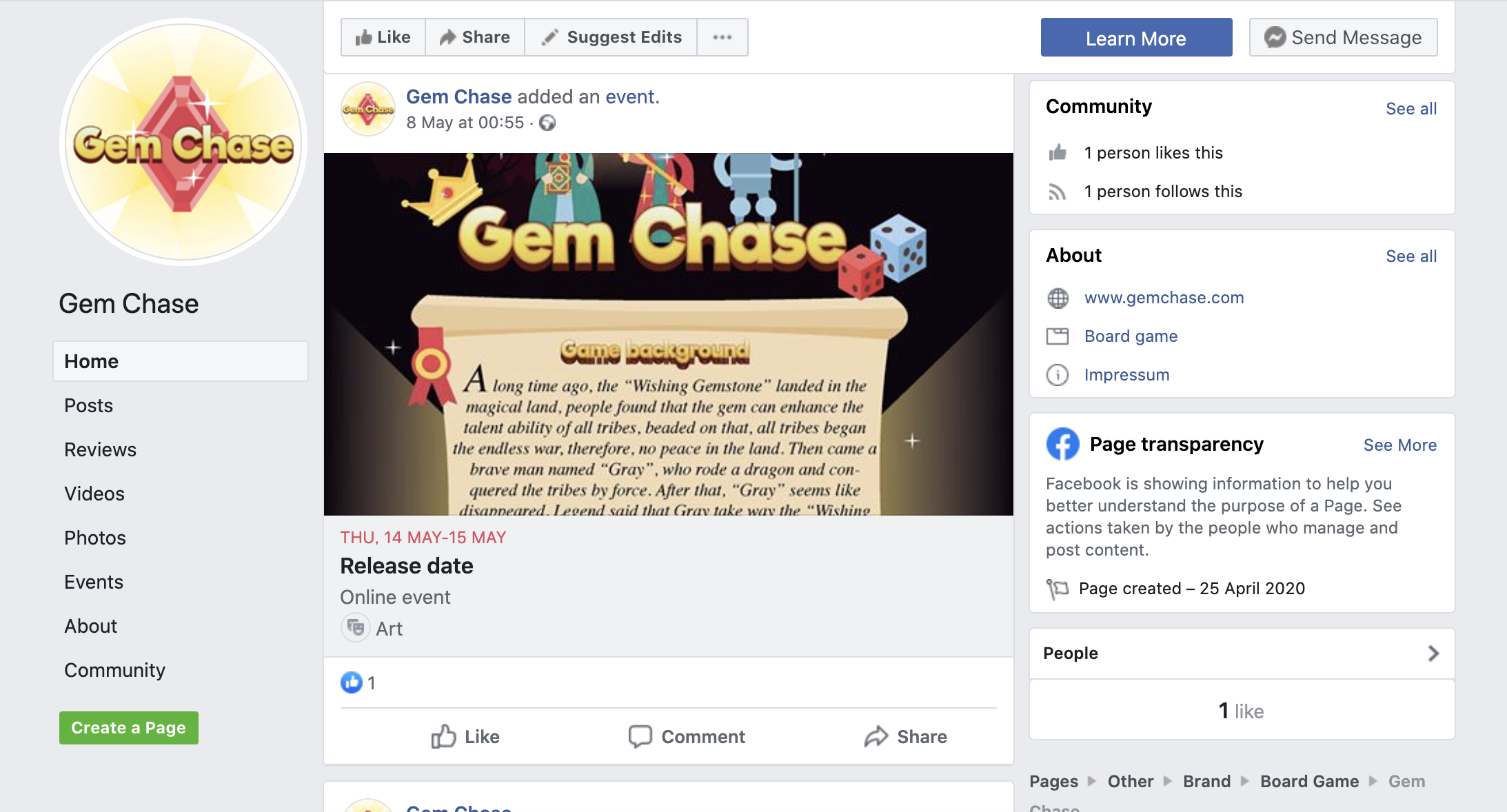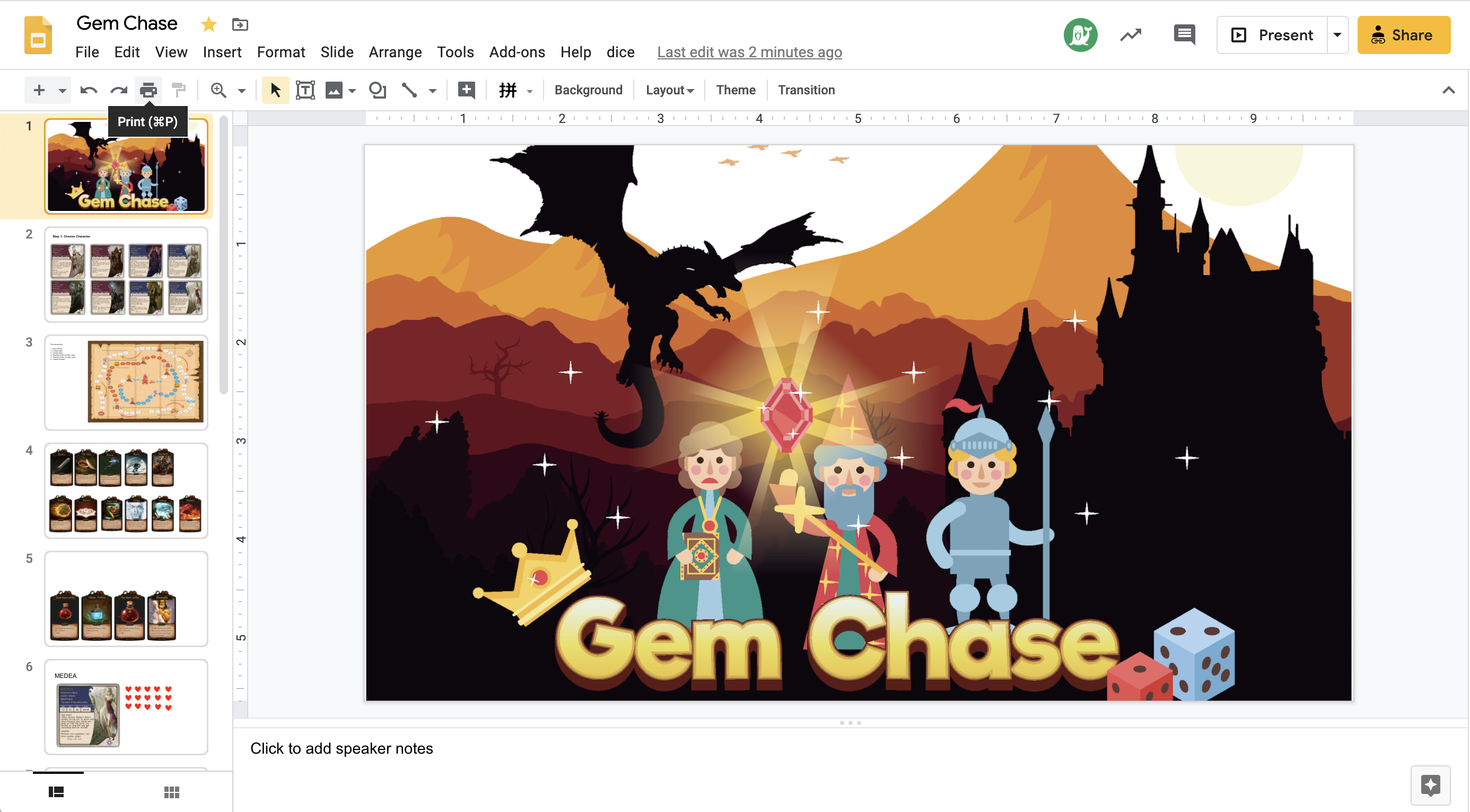Project title: Gem chase
Introduction
Gem Chase is a board game where competition and cooperation coexist. Players need to reach the finish destination in the shortest time or defeat rival players to win.
See our game video here:
https://youtu.be/8xr_E9B0z0Q
Presenting the Project

Figure 1. Screenshot from Gem Chase website
(https://www.gemchase.com/)
In our GM2 group project for this term, we designed a playable board games Gem Chase. All the wonderful content about the game, including the narrative, game mechanics, characters, CARDS, update process, peripheral products, team division are on our website, please do explore everything there.

Figure 2. Screenshot from Facebook
(https://www.facebook.com/Gem-Chase-112672830422332/)
We also created social platforms and communities where players can discuss and give feedback, including Instagram, Facebook, and Baidu (As a online gaming community).
The main target groups of Gem Chase are teenagers and home users. Designers are more willing to develop games for everyone because the size of the game market means potential profit growth (Sykes, 2006). In the early stage of Gem Chase design, the target group was set very broadly, because Gem Chase is a board game with low hand-on defects, balanced male and female roles, and combat elements far exceeding the level of bloody violence, but in general, Gem Chase is more Suitable for crowds and family gatherings, this is determined according to Gem Chase usage scenarios.

Figure 3. Screenshot from Google Slides
(https://docs.google.com/presentation/d/1cBpukxrAb0NiHJMinLUsOD37t7Gq96t3Ckcz9RjRQuo/edit#slide=id.g8449bc7157_0_17)
However, due to the epidemic, people can’t go out of their homes and get together to play games face to face. We designed an online version for Gem Chase as a response. We’ve done this with Google drive (As shown in figure 3) ,where each player can create a page of their own character that includes the game’s character, health, and the CARDS the player owns. They can complete the game by moving their ICONS around on the public map page.
Define the game classification and game design of gem chase
It mainly refers to the research on game classification and game design by Elverdam and Aarseth (2007).
There are two common ways to describe the game, the first is the comparison between games, and the other is to refer to one or more types (Elverdam and Aarseth, 2007). In the gem chase, you can see the traces of the classic board games of Monopoly, Dragon and Dungeon, which makes it easier for novices to get started, because players can refer to the rules of these classic games, but the specific rules of the game still need to be learned .
In terms of DImension level, these three elements form the concept of game time that Representation and teleology represent the relationship between game and reality, and Pace represents the time within the game( Aarseth et al, 2003 citied in Elverdam and Aarseth, 2007). The time in gem chase is defined as Pace is the number of steps determined by the dice in a single round, as well as the events or skills launched during the round. Representation is used by all players in the game The end time of a round corresponds to the day of the game world. Teleology is set to reach the end or kill all hostile players as an end condition, not ends at a given time.
Elverdam and Aarseth (2007) also define the virtual space, Perspective determines the player’s game vision, Positioning helps the player to determine the relative position in the game, and Environment dynamics determines whether the player can modify the game space. In the gem chase, our map is clear at a glance, and there is no obstruction of vision. We use numbers to help players locate, corresponding to the number of dice, the action is more accurate. In terms of Environment dynamics, our map is designed from the ground up, unless experience problems, players are not allowed to modify the game space, which is similar to Chess type games, so we do not have Environment dynamics.
In Player composition, Gem Chase competes for two teams, each player’s skill is different, and the position of the game character in the representative is different, mainly for output and support. According to Koivisto (2003), this asymmetric character skill design and teaming system can encourage cooperation between players to enhance social interaction. In terms of game evaluation, individual victory is the victory of the whole team, and the victory conditions of the game are fixed, that is, the first to reach the end or kill the enemy player.
The passage of time will put pressure on players, whether it is turn-based or real-time games (Elverdam and Aarseth, 2007). This is the core of the gem chase, restricting the opponent’s advancement while ensuring that you can deploy the most in a single round. By performing interval control, not only can the rush of the game be eliminated, but also synchronization can be maintained to some extent (Elverdam and Aarseth, 2007). Players are more engaged because of synchronization without losing their purpose.
Project development plan
In terms of future development, we use the user experience questionnaire to get feedback on the game. Based on the specific problems of the feedback, we formulate the following development strategies.
a. Improve the game rhythm to avoid the problem of turn-based game players waiting too long. The specific solution is to use a countdown to limit the player’s turn time.
b. Make small adjustments according to different game media. Some electronic versions add an online host to guide players to get started quickly. The board game version needs more attention for the game narrative, and the board game’s narrative presentation ability is much smaller than the electronic version.
c. Optimize the online digital version and provide portable mobile applications to gain more users.
d. Establish a diverse online gaming community and use it as a communication platform to encourage creation and communication among players.
Group Roles
Narrative: Zhuoyu Zhang
Design Team: Hao Wu, Xiang Li
Social Media team: Jiahao Zhang, Ruohan Tang
Game mechanism design:Yi Zuo, Zihan Gao, Youpeng Fu
Reference: Elverdam, C. and Aarseth, E. (2007) ‘Game Classification and Game Design: Construction Through Critical Analysis’, Games and Culture, 2(1), pp. 3–22. doi: 10.1177/1555412006286892. Koivisto, E.M. (2003) Supporting Communities in Massively Multiplayer Online RolePlaying Games by Game Design. DiGRA ’03 – Proceedings of the 2003 DiGRA International Conference, 4-6 November. Utrecht, The Netherlands. Sykes, J. (2006). A player-centred approach to digital game design. In J. Rutter & J. Bryce (Eds.), Understanding digital games (pp. 75-92). London: SAGE Publications Ltd doi: 10.4135/9781446211397.n5
_画板-1.jpg)